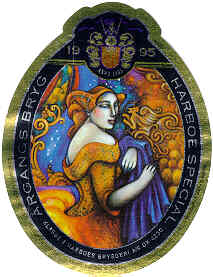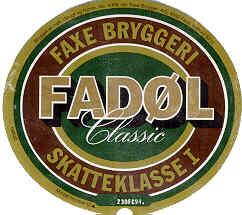Starting with one of my favourite processes, lagering. I've seen a fair bit of discussion on homebrewing fora about how long you need to lager and even whether there's any point in bulk lagering at all. I won't claim to understand the science, but from my experience drinking beer, a proper long lagering definitely helps. All the Franconian beers I love get at least two months.
"Lagering.—The green beer was racked to the lager cellar by pumping. The yeast had usually compacted firmly on the floor of the fermenting vessel and it was not appreciably disturbed during racking, so that a retaining collar was rarely necessary. Much mixing of gyles took place in order to obtain a consistent product and also, where the method was in use, to mix yeast types. At this point in the process precipitating agents such as tannic acid were sometimes added.
Cellars were maintained at about 32° F. and the beer was allowed to reach this temperature naturally, standing in tanks which were bunged about a day after filling, either column-wise or singly. Many cellars were vast underground refrigerated passages, but new installations above ground enclosed the tanks in cold rooms, leaving the ends accessible from a working passage at room temperature. Enamelled iron, aluminium and stainless steel were used for lager tank construction, with aluminium now predominant. Pressures were allowed to rise to about 4 lb. per sq. in., which is lower than in Germany where subsequent carbonation is not allowed, and the average storage time was up to 3 months for Pilsner types and 6 months for very strong beers."
Journal of the Institute of Brewing, Volume 66, 1960, pages 497 - 498.
Blending gyles is typical of big industrial breweries who want to maintain absolute consistency of flavour. For me part of the charm of some beers is that there are slight variations from batch to batch. Makes life more interesting.
The lagering process sounds pretty traditional: gradual cooling to about freezing point and bunging the lagering vessels to allow the beer to carbonate. Though obviously they didn't solely rely on natural carbonation as the Germans did. Funnily enough I know from documents in the Barclay Perkins archives that Harp Lager was bunged and naturally-carbonated in the early 1960's
Now filtration, a vital part of Lager production.
"Filtration and bottling.— In 14 of the 16 breweries visited in Denmark and Germany, the final polishing filtration was given by a pure cotton cellulose pulp filter of the Enzinger type. Pulp polishing was considered essential for stability of the finished beer, in spite of the disadvantage of regenerating and sterilizing the pulp and the possible loss of beer quality. Four of the Danish breweries used a battery of centrifuges for rough filtration, with additional cooling equipment between the centrifuges and the pulp filter; they were not so efficient as kieselguhr rough filters and they thrust more load on to the polisher. For example, a 50-plate pulp filter used after a centrifugal pre-filter passed about 300 brl. before choking whereas 400 brl. were passed after prefiltration by kieselguhr. The sludge from the lager tanks was usually filtered through a cloth filterpress, and the beer recovered was led through the main filtration plant and metered into fresh bright beer."
Journal of the Institute of Brewing, Volume 66, 1960, page 498.
I've included that for information purposes only I can't claim to understand hardly any of it. My knowledge of filtration methods is close to zero. Not anything I ever bothered with when home brewing. Very efficient of them to recover the beer in the yeast sludge. Better than the disgusting practice of some British breweries of reusing returned beer.
Now they're fizzing the beer up.
"Carbonation took place just before the pulp filtration, and bright-beer tanks were usually glass lined. Two large breweries had a rigorous check on dissolved air before bottling, and any excess over 2 ml. per litre was scrubbed out by bubbling carbon dioxide through the tank. The extent of carbonation was standardized and chill-proofing agents were sometimes added. Bottling lines were always well laid out, with hot water spray pasteurization in bottle commonly applied; the usual practice of a 20-min. hold at 143° F. for a 0.33-litre bottle seemed rather drastic."
Journal of the Institute of Brewing, Volume 66, 1960, page 498.
I can't really say much about this either. Other than that large breweries were clearly concerned about oxidation and that pasteurisation seems to have been standard. Though that was also true of British bottled beer at the time, with just a handful of exceptions.
Finally, draught and canned beer.
"Keg beer constituted a proportion of the home trade of some breweries, and here pasteurization by complete immersion was favoured for thorough heat transfer and so that leaking kegs could be detected. Export beer in bulk was flash pasteurized. Canning was rather the province of the major concerns, but it was obviously on the increase and at least one firm was preparing to raise its output of canned beer extensively. Standards of stability for beer in bottle were high. Vibration and forcing tests were regularly carried out with, e.g., one type of beer being expected to withstand a temperature of 140° F. for 3 months without throwing an appreciable haze."
Journal of the Institute of Brewing, Volume 66, 1960, page 498.
I can remember being shocked during my first visit to Copenhagen back in the 1980's at the almost total absence of draught beer. Even in largish city-centre pubs, draught beer was rare, except in British or Irish pubs. It was the only real beer-drinking country where bottles so completely dominated the pub trade. That's one of the many aspects of the Danish brewing scene which have completely changed. Now draught beer is everywhere.
It sounds as if not all breweries really bothered with draught in 1960, but some did. But presumably between 1960 and 1980 even those gave up on it.
Next we'll be looking at German brewing in 1960.












































































4 comments:
There was a reference on B&B's site to a British brewery in the mid-1940's using asbestos filtering for bottling and the need to clean and re-sterilize the filters. Obviously at this time this material was permitted in the breweries but by circa-1960 perhaps not since there is no reference to it in the report you quoted. Or maybe practice had always differed in parts of the Continent.
Regarding the filtration discussion, I think he is saying if the beer enters the final phase of filtration (polishing) without being fully filtered, e.g., if it is centrifuged, the polishing filters will fail (choke) sooner because the beer has too much residual yeast and protein.
Gary Gillman
I've heard that beer recovered from pressed yeast tastes foul.
Over the past ten years the
Industry has become increasingly concerned about the
health aspects of asbestos. While there is the possibility of
asbestos fibres ending up in the filtered beer,2 the case for a
hazard to health from ingestion of asbestos is by no means
proven. Even so, sensitivity to public concern and the more
real hazard to operators handling the cloth, have caused
many brewers to drop the use of asbestos.
One popular alternative to asbestos are sheets impreg
nated with kieselguhr. If the content of kieselguhr is graded
through the sheet to give higher voidage on the inlet rather
than the outlet,3 then overall performance is enhanced. By
modifying the production of the cellulose fibre it is possible
to control the uptake of kieselguhr resulting in sheets of
good particle retention and high volumetric throughput.11
Regeneration of the exhausted sheets is possible by backwashing,
say once every 24 hours. Other cellulose sheets,
impregnated with resins and other man-made materials are
also available, with grades suitable for coarse clarification
to fine polishing and sterilising.
Types of Equipment
In the UK the best known sheet filter is of the plate and
frame type, similar to that used in bodyfeed filtration,
except that the frame section is much thinner, its function
being simply to distribute the flow of beer over the entire
surface of the sheet. Sheets are regenerated by backwashing
but have to be replaced every few months. Because of the
low permeability of the sheet material, and the need for low
pressure drops (as a sheet filter is frequently used directly in
series with a kieselguhr filter), surface loading is generally
low, e.g. a value of 1 hi m " 2h "l is not unusual.
Another system still used on the grand scale in one
American brewery is the Enzinger pulp filter, which system
comprises a series of 500 mm diameter pulp pads, thickness
40 to 43 mm, operated in parallel. The pads are held in filter
plates, which look, to all intents and purposes, like small cir
cular plate and frame units. The pulp pads are not backwashed,
as this would break up the pad, but neither are they
discarded. Instead, the pads are pulped in water after which
the cellulose mass is washed and re-formed into pads for
re-use. Traditionally asbestos was added to the cellulose
to enhance filtration performance, though this has been
replaced by a charged modified cellulose fibre.1
Cartridge Filters
A cartridge filter may be defined as a small enclosed unit
J. Inst. Brew., September-October, 1986, Vol. 92, pp. 413-419
http://onlinelibrary.wiley.com/doi/10.1002/j.2050-0416.1986.tb04433.x/pdf
Ed -
Not foul, but certainly not best quality. Large breweries don't put this recovered beer in their premium brands.
Post a Comment